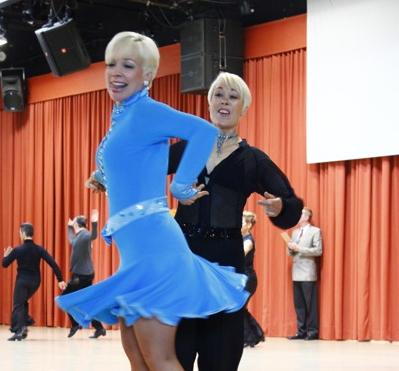Had TLC’s Dance Moms lead me astray? I expected cut-throat twirlers and an atmosphere you could cut with a sharpened acrylic nail when I arrived at the April Follies same-sex dance competition on April 27.
But against all television precedent, the vibe at Follies’ 11th annual competition, which was held at Just Dance Ballroom in Oakland had more to do with back pats than stabs. Competing dancers joked around on stage and cheered each other on from the sidelines. During breaks, contestants and supporters danced together for fun. For fun!

Kalin Mitov and Michael Winward from Boston
April Follies is the largest and longest running same-sex dance competition in North America. Open to beginners and professionals alike, the event drew in competitors all the way from places such as Boston, Denmark, and London.
The all-day event began with competitions for beginner and intermediate dancers in styles such as: American smooth, West Coast swing, country-western, and Argentine tango. The competition went on pause for a buffet dinner, free dance lessons, and dance social, resuming in the evening with the “Showcase of Champions,” for which the more advanced dancers took to the stage.
Competitors rehearse in Just Dance Ballroom
April Follies organizer Barbra Zoloth tells me that the competitive same-sex dance community emerged Stateside when the dance world got wind of the fact that there were a significant amount of same-sex dancers out there cutting a rug. “[Dance authorities] added to their rules that the definition of a couple is a man and a woman,” Zoloth says. “The only way we could compete, the only way we could have our own sort of same-sex dance community, was to create our own competitions.”
Just as it is in the queer community’s debates over gay marriage, the issue of whether assimilation equals equality is a frequently debated topic in the dance world. Zoloth says some would like to be accepted into mainstream competitions because it is only fair to have equal opportunity, whereas others aren’t so interested in a merger because it won’t feel as comfortable and supportive as the atmosphere that rules in same-sex competitions.

Competitors and their supporters danced together during breaks
To be eligible to compete in the Follies, couples must both be the same sex, or have a female leader and male follower – no opposite sex, male leading couples are allowed here.
But Zoloth wants it to be clear that the event isn’t meant to exclude anyone. “We don’t care what people’s sexual preferences are,” she says. “We got straight people. We got gay people. We got in-between people. As long as it’s either two women, two men, or a female leader, male follower you’re welcome.”
The competitors at April Follies appeared genuinely happy to be part of this small, but growing community. Certainly, when everyone knows and dances with everyone, it becomes difficult to scowl at your competition.
Competitors line up on stage for the results
As I speak with professional dancer and owner of Vima Dance Studio, Photis Pishiaras he informs me that three of his students were performing alongside him in the competition. April Follies event organizer Phil Siegel chimes in to say that he also dances a Pishiaras’ studio, and proceeded to give it a rave review.
Politics aside, April Follies was at its core a bright day for the same-sex dance community to come together and do what they love. Pishiaras puts it best when he says, “whether it’s same-sex or straight, dancing is dancing.”
For a full list of 2013 Follies competition winners, dance over here

